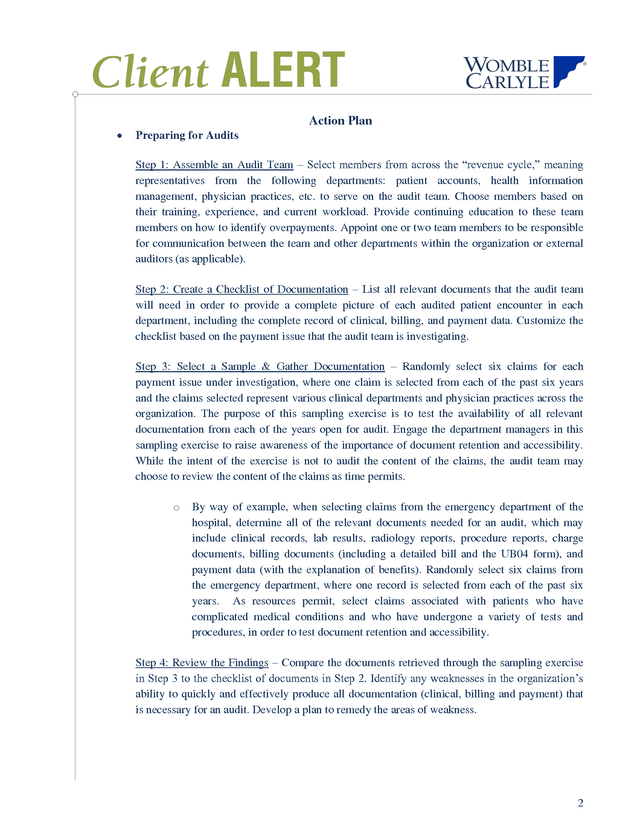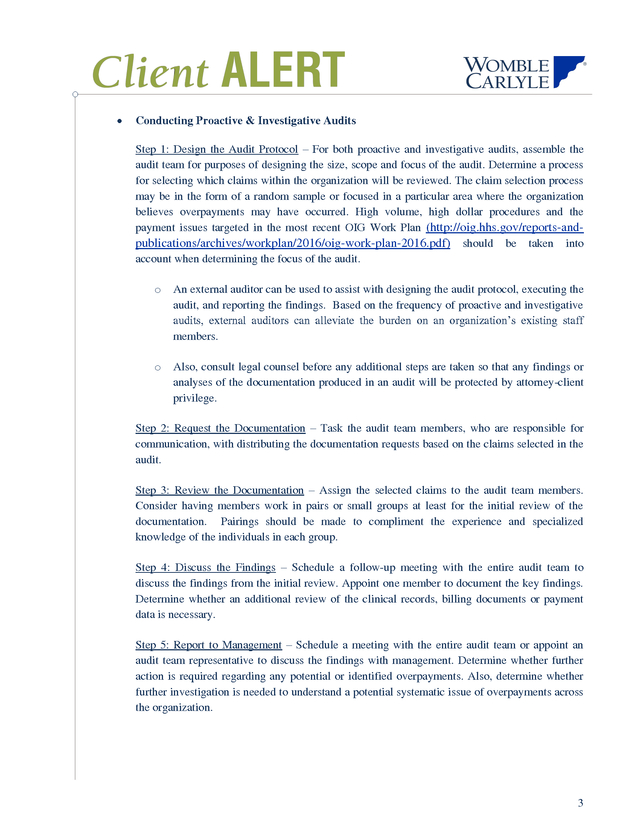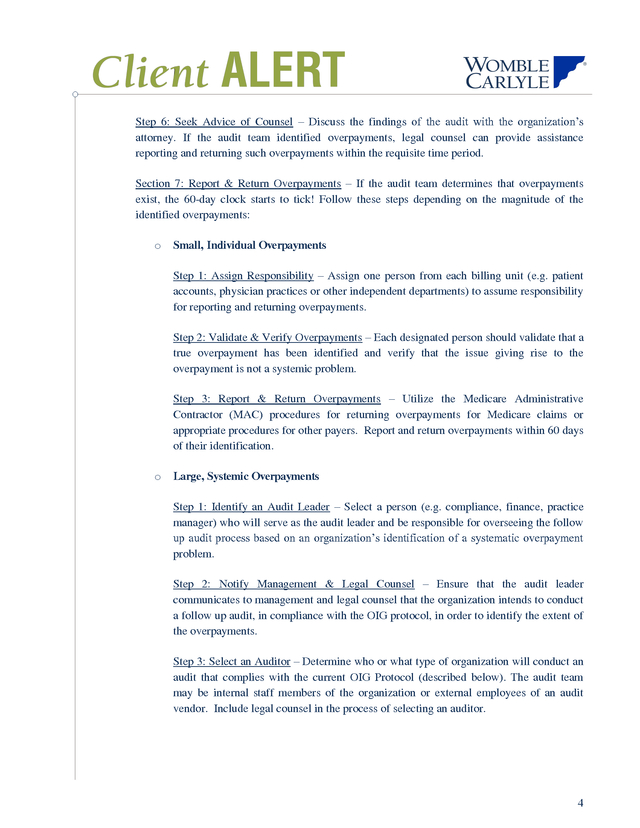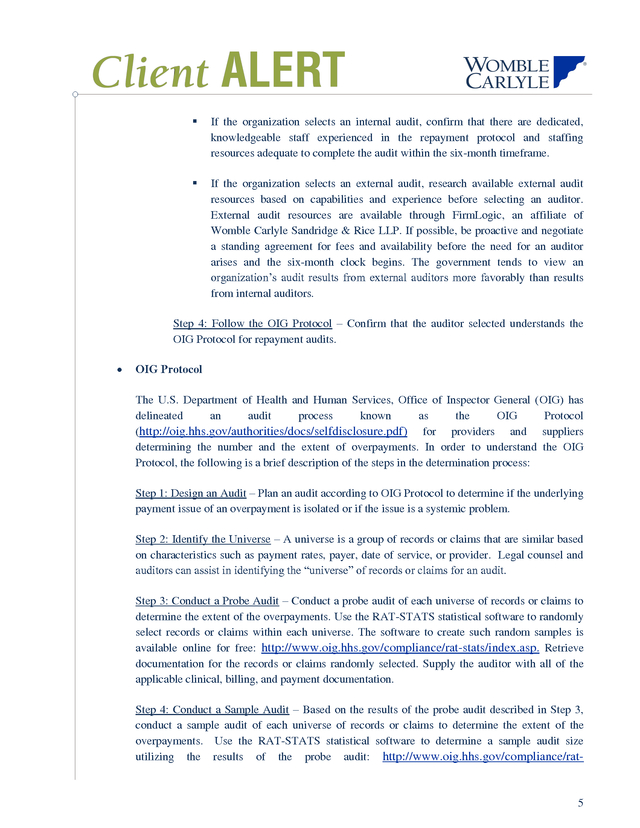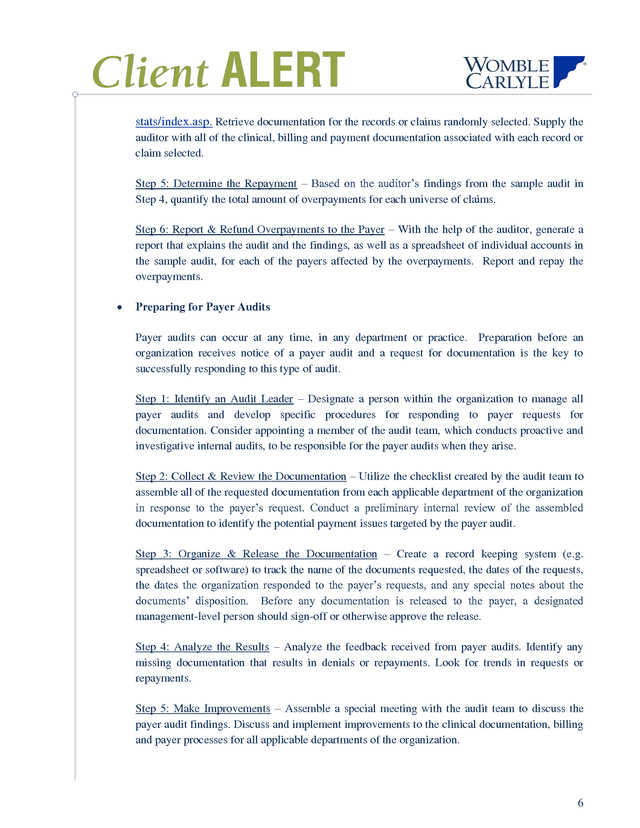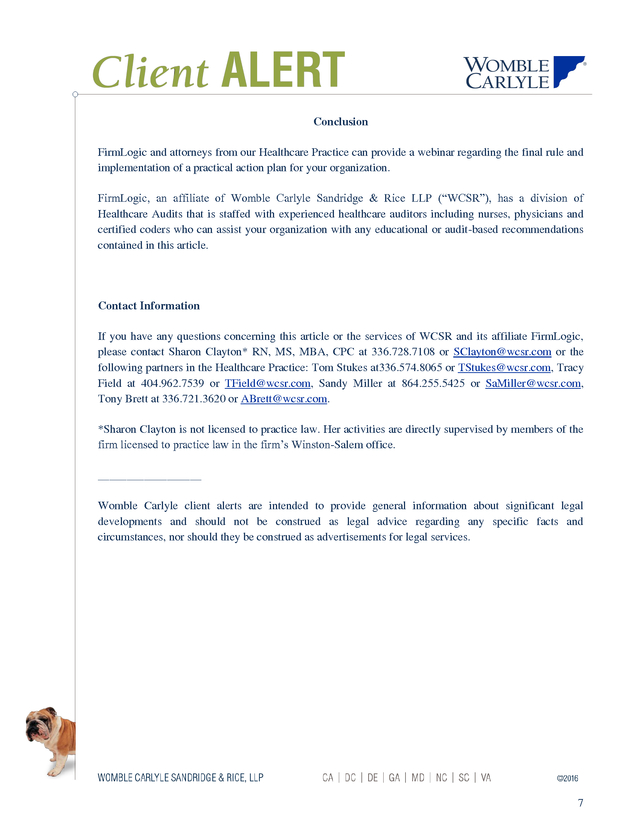Next Steps: Helping Your Organization Implement the New Medicare Overpayment Rule – PART - II - April 18, 2016
Womble Carlyle Sandridge & Rice
Description
Next Steps: Helping Your Organization Implement the New Medicare
Overpayment Rule
April 15, 2016
Part II: An Action Plan for Complying with the Final Rule for Reporting
and Returning Overpayments
On February 12, 2016, the Centers for Medicare & Medicaid Services (“CMS”) published a final rule
that explains the requirements for providers and suppliers reporting and returning overpayments under
Medicare Parts A & B (the “Overpayment Rule”). It took CMS nearly six years to finalize the
Overpayment Rule after Section 1128J(d) of the Patient Protection and Affordable Care Act became law
and explicitly required providers and suppliers to return overpayments to Medicare.
In our experience, the three worst enemies to meeting the deadline set by CMS in the Overpayment Rule
are an organization’s inability to quickly organize an audit team when an overpayment is identified,
difficulty locating key documentation related to the overpayment, and limitations on staff resources to
review the applicable documentation. With this in mind, we provided below descriptions of various audit
scenarios. We also outlined an “Action Plan” that will help your organization avoid pitfalls that will cost
you time and money.
Types of Audits
ï‚·
Proactive Audits: According to CMS commentary on the Overpayment Rule, an organization
cannot avoid having knowledge of overpayments by ignoring credible evidence that an
overpayment has occurred.
This means that an organization should conduct proactive, internal and/or external audits, on a regular basis (e.g. monthly, quarterly, annually) in order to determine whether the organization has received overpayments. ï‚· Investigative Audits: When an organization receives credible evidence of a potential overpayment, CMS clarified in the Overpayment Rule that an organization has six months to investigate whether an overpayment exists. When an organization identifies an overpayment, through investigation or audit, an organization then has 60 days from the completion of the investigation or audit to report and return the overpayment. ï‚· Payer Audits: A payer audit can come from a number of sources both public (OIG, RAC, MAC, CERT) and private.
A payer audit consists of a request for records and either an on-site or remote audit conducted by the payer’s auditors. All providers and suppliers should develop plans to navigate each type of audit process. The following is a template “Action Plan,” which your organization can use and build upon in order to ensure compliance with the Overpayment Rule. 1 . ï‚· Action Plan Preparing for Audits Step 1: Assemble an Audit Team – Select members from across the “revenue cycle,” meaning representatives from the following departments: patient accounts, health information management, physician practices, etc. to serve on the audit team. Choose members based on their training, experience, and current workload. Provide continuing education to these team members on how to identify overpayments.
Appoint one or two team members to be responsible for communication between the team and other departments within the organization or external auditors (as applicable). Step 2: Create a Checklist of Documentation – List all relevant documents that the audit team will need in order to provide a complete picture of each audited patient encounter in each department, including the complete record of clinical, billing, and payment data. Customize the checklist based on the payment issue that the audit team is investigating. Step 3: Select a Sample & Gather Documentation – Randomly select six claims for each payment issue under investigation, where one claim is selected from each of the past six years and the claims selected represent various clinical departments and physician practices across the organization. The purpose of this sampling exercise is to test the availability of all relevant documentation from each of the years open for audit.
Engage the department managers in this sampling exercise to raise awareness of the importance of document retention and accessibility. While the intent of the exercise is not to audit the content of the claims, the audit team may choose to review the content of the claims as time permits. o By way of example, when selecting claims from the emergency department of the hospital, determine all of the relevant documents needed for an audit, which may include clinical records, lab results, radiology reports, procedure reports, charge documents, billing documents (including a detailed bill and the UB04 form), and payment data (with the explanation of benefits). Randomly select six claims from the emergency department, where one record is selected from each of the past six years. As resources permit, select claims associated with patients who have complicated medical conditions and who have undergone a variety of tests and procedures, in order to test document retention and accessibility. Step 4: Review the Findings – Compare the documents retrieved through the sampling exercise in Step 3 to the checklist of documents in Step 2.
Identify any weaknesses in the organization’s ability to quickly and effectively produce all documentation (clinical, billing and payment) that is necessary for an audit. Develop a plan to remedy the areas of weakness. 2 . ï‚· Conducting Proactive & Investigative Audits Step 1: Design the Audit Protocol – For both proactive and investigative audits, assemble the audit team for purposes of designing the size, scope and focus of the audit. Determine a process for selecting which claims within the organization will be reviewed. The claim selection process may be in the form of a random sample or focused in a particular area where the organization believes overpayments may have occurred. High volume, high dollar procedures and the payment issues targeted in the most recent OIG Work Plan (http://oig.hhs.gov/reports-andpublications/archives/workplan/2016/oig-work-plan-2016.pdf) should be taken into account when determining the focus of the audit. o An external auditor can be used to assist with designing the audit protocol, executing the audit, and reporting the findings.
Based on the frequency of proactive and investigative audits, external auditors can alleviate the burden on an organization’s existing staff members. o Also, consult legal counsel before any additional steps are taken so that any findings or analyses of the documentation produced in an audit will be protected by attorney-client privilege. Step 2: Request the Documentation – Task the audit team members, who are responsible for communication, with distributing the documentation requests based on the claims selected in the audit. Step 3: Review the Documentation – Assign the selected claims to the audit team members. Consider having members work in pairs or small groups at least for the initial review of the documentation. Pairings should be made to compliment the experience and specialized knowledge of the individuals in each group. Step 4: Discuss the Findings – Schedule a follow-up meeting with the entire audit team to discuss the findings from the initial review. Appoint one member to document the key findings. Determine whether an additional review of the clinical records, billing documents or payment data is necessary. Step 5: Report to Management – Schedule a meeting with the entire audit team or appoint an audit team representative to discuss the findings with management.
Determine whether further action is required regarding any potential or identified overpayments. Also, determine whether further investigation is needed to understand a potential systematic issue of overpayments across the organization. 3 . Step 6: Seek Advice of Counsel – Discuss the findings of the audit with the organization’s attorney. If the audit team identified overpayments, legal counsel can provide assistance reporting and returning such overpayments within the requisite time period. Section 7: Report & Return Overpayments – If the audit team determines that overpayments exist, the 60-day clock starts to tick! Follow these steps depending on the magnitude of the identified overpayments: o Small, Individual Overpayments Step 1: Assign Responsibility – Assign one person from each billing unit (e.g. patient accounts, physician practices or other independent departments) to assume responsibility for reporting and returning overpayments. Step 2: Validate & Verify Overpayments – Each designated person should validate that a true overpayment has been identified and verify that the issue giving rise to the overpayment is not a systemic problem. Step 3: Report & Return Overpayments – Utilize the Medicare Administrative Contractor (MAC) procedures for returning overpayments for Medicare claims or appropriate procedures for other payers. Report and return overpayments within 60 days of their identification. o Large, Systemic Overpayments Step 1: Identify an Audit Leader – Select a person (e.g.
compliance, finance, practice manager) who will serve as the audit leader and be responsible for overseeing the follow up audit process based on an organization’s identification of a systematic overpayment problem. Step 2: Notify Management & Legal Counsel – Ensure that the audit leader communicates to management and legal counsel that the organization intends to conduct a follow up audit, in compliance with the OIG protocol, in order to identify the extent of the overpayments. Step 3: Select an Auditor – Determine who or what type of organization will conduct an audit that complies with the current OIG Protocol (described below). The audit team may be internal staff members of the organization or external employees of an audit vendor. Include legal counsel in the process of selecting an auditor. 4 .
 If the organization selects an internal audit, confirm that there are dedicated, knowledgeable staff experienced in the repayment protocol and staffing resources adequate to complete the audit within the six-month timeframe.  If the organization selects an external audit, research available external audit resources based on capabilities and experience before selecting an auditor. External audit resources are available through FirmLogic, an affiliate of Womble Carlyle Sandridge & Rice LLP. If possible, be proactive and negotiate a standing agreement for fees and availability before the need for an auditor arises and the six-month clock begins. The government tends to view an organization’s audit results from external auditors more favorably than results from internal auditors. Step 4: Follow the OIG Protocol – Confirm that the auditor selected understands the OIG Protocol for repayment audits. ï‚· OIG Protocol The U.S. Department of Health and Human Services, Office of Inspector General (OIG) has delineated an audit process known as the OIG Protocol (http://oig.hhs.gov/authorities/docs/selfdisclosure.pdf) for providers and suppliers determining the number and the extent of overpayments.
In order to understand the OIG Protocol, the following is a brief description of the steps in the determination process: Step 1: Design an Audit – Plan an audit according to OIG Protocol to determine if the underlying payment issue of an overpayment is isolated or if the issue is a systemic problem. Step 2: Identify the Universe – A universe is a group of records or claims that are similar based on characteristics such as payment rates, payer, date of service, or provider. Legal counsel and auditors can assist in identifying the “universe” of records or claims for an audit. Step 3: Conduct a Probe Audit – Conduct a probe audit of each universe of records or claims to determine the extent of the overpayments. Use the RAT-STATS statistical software to randomly select records or claims within each universe.
The software to create such random samples is available online for free: http://www.oig.hhs.gov/compliance/rat-stats/index.asp. Retrieve documentation for the records or claims randomly selected. Supply the auditor with all of the applicable clinical, billing, and payment documentation. Step 4: Conduct a Sample Audit – Based on the results of the probe audit described in Step 3, conduct a sample audit of each universe of records or claims to determine the extent of the overpayments.
Use the RAT-STATS statistical software to determine a sample audit size utilizing the results of the probe audit: http://www.oig.hhs.gov/compliance/rat- 5 . stats/index.asp. Retrieve documentation for the records or claims randomly selected. Supply the auditor with all of the clinical, billing and payment documentation associated with each record or claim selected. Step 5: Determine the Repayment – Based on the auditor’s findings from the sample audit in Step 4, quantify the total amount of overpayments for each universe of claims. Step 6: Report & Refund Overpayments to the Payer – With the help of the auditor, generate a report that explains the audit and the findings, as well as a spreadsheet of individual accounts in the sample audit, for each of the payers affected by the overpayments. Report and repay the overpayments. ï‚· Preparing for Payer Audits Payer audits can occur at any time, in any department or practice.
Preparation before an organization receives notice of a payer audit and a request for documentation is the key to successfully responding to this type of audit. Step 1: Identify an Audit Leader – Designate a person within the organization to manage all payer audits and develop specific procedures for responding to payer requests for documentation. Consider appointing a member of the audit team, which conducts proactive and investigative internal audits, to be responsible for the payer audits when they arise. Step 2: Collect & Review the Documentation – Utilize the checklist created by the audit team to assemble all of the requested documentation from each applicable department of the organization in response to the payer’s request. Conduct a preliminary internal review of the assembled documentation to identify the potential payment issues targeted by the payer audit. Step 3: Organize & Release the Documentation – Create a record keeping system (e.g. spreadsheet or software) to track the name of the documents requested, the dates of the requests, the dates the organization responded to the payer’s requests, and any special notes about the documents’ disposition.
Before any documentation is released to the payer, a designated management-level person should sign-off or otherwise approve the release. Step 4: Analyze the Results – Analyze the feedback received from payer audits. Identify any missing documentation that results in denials or repayments. Look for trends in requests or repayments. Step 5: Make Improvements – Assemble a special meeting with the audit team to discuss the payer audit findings.
Discuss and implement improvements to the clinical documentation, billing and payer processes for all applicable departments of the organization. 6 . Conclusion FirmLogic and attorneys from our Healthcare Practice can provide a webinar regarding the final rule and implementation of a practical action plan for your organization. FirmLogic, an affiliate of Womble Carlyle Sandridge & Rice LLP (“WCSR”), has a division of Healthcare Audits that is staffed with experienced healthcare auditors including nurses, physicians and certified coders who can assist your organization with any educational or audit-based recommendations contained in this article. Contact Information If you have any questions concerning this article or the services of WCSR and its affiliate FirmLogic, please contact Sharon Clayton* RN, MS, MBA, CPC at 336.728.7108 or SClayton@wcsr.com or the following partners in the Healthcare Practice: Tom Stukes at336.574.8065 or TStukes@wcsr.com, Tracy Field at 404.962.7539 or TField@wcsr.com, Sandy Miller at 864.255.5425 or SaMiller@wcsr.com, Tony Brett at 336.721.3620 or ABrett@wcsr.com. *Sharon Clayton is not licensed to practice law. Her activities are directly supervised by members of the firm licensed to practice law in the firm’s Winston-Salem office. __________________ Womble Carlyle client alerts are intended to provide general information about significant legal developments and should not be construed as legal advice regarding any specific facts and circumstances, nor should they be construed as advertisements for legal services. 7 .
This means that an organization should conduct proactive, internal and/or external audits, on a regular basis (e.g. monthly, quarterly, annually) in order to determine whether the organization has received overpayments. ï‚· Investigative Audits: When an organization receives credible evidence of a potential overpayment, CMS clarified in the Overpayment Rule that an organization has six months to investigate whether an overpayment exists. When an organization identifies an overpayment, through investigation or audit, an organization then has 60 days from the completion of the investigation or audit to report and return the overpayment. ï‚· Payer Audits: A payer audit can come from a number of sources both public (OIG, RAC, MAC, CERT) and private.
A payer audit consists of a request for records and either an on-site or remote audit conducted by the payer’s auditors. All providers and suppliers should develop plans to navigate each type of audit process. The following is a template “Action Plan,” which your organization can use and build upon in order to ensure compliance with the Overpayment Rule. 1 . ï‚· Action Plan Preparing for Audits Step 1: Assemble an Audit Team – Select members from across the “revenue cycle,” meaning representatives from the following departments: patient accounts, health information management, physician practices, etc. to serve on the audit team. Choose members based on their training, experience, and current workload. Provide continuing education to these team members on how to identify overpayments.
Appoint one or two team members to be responsible for communication between the team and other departments within the organization or external auditors (as applicable). Step 2: Create a Checklist of Documentation – List all relevant documents that the audit team will need in order to provide a complete picture of each audited patient encounter in each department, including the complete record of clinical, billing, and payment data. Customize the checklist based on the payment issue that the audit team is investigating. Step 3: Select a Sample & Gather Documentation – Randomly select six claims for each payment issue under investigation, where one claim is selected from each of the past six years and the claims selected represent various clinical departments and physician practices across the organization. The purpose of this sampling exercise is to test the availability of all relevant documentation from each of the years open for audit.
Engage the department managers in this sampling exercise to raise awareness of the importance of document retention and accessibility. While the intent of the exercise is not to audit the content of the claims, the audit team may choose to review the content of the claims as time permits. o By way of example, when selecting claims from the emergency department of the hospital, determine all of the relevant documents needed for an audit, which may include clinical records, lab results, radiology reports, procedure reports, charge documents, billing documents (including a detailed bill and the UB04 form), and payment data (with the explanation of benefits). Randomly select six claims from the emergency department, where one record is selected from each of the past six years. As resources permit, select claims associated with patients who have complicated medical conditions and who have undergone a variety of tests and procedures, in order to test document retention and accessibility. Step 4: Review the Findings – Compare the documents retrieved through the sampling exercise in Step 3 to the checklist of documents in Step 2.
Identify any weaknesses in the organization’s ability to quickly and effectively produce all documentation (clinical, billing and payment) that is necessary for an audit. Develop a plan to remedy the areas of weakness. 2 . ï‚· Conducting Proactive & Investigative Audits Step 1: Design the Audit Protocol – For both proactive and investigative audits, assemble the audit team for purposes of designing the size, scope and focus of the audit. Determine a process for selecting which claims within the organization will be reviewed. The claim selection process may be in the form of a random sample or focused in a particular area where the organization believes overpayments may have occurred. High volume, high dollar procedures and the payment issues targeted in the most recent OIG Work Plan (http://oig.hhs.gov/reports-andpublications/archives/workplan/2016/oig-work-plan-2016.pdf) should be taken into account when determining the focus of the audit. o An external auditor can be used to assist with designing the audit protocol, executing the audit, and reporting the findings.
Based on the frequency of proactive and investigative audits, external auditors can alleviate the burden on an organization’s existing staff members. o Also, consult legal counsel before any additional steps are taken so that any findings or analyses of the documentation produced in an audit will be protected by attorney-client privilege. Step 2: Request the Documentation – Task the audit team members, who are responsible for communication, with distributing the documentation requests based on the claims selected in the audit. Step 3: Review the Documentation – Assign the selected claims to the audit team members. Consider having members work in pairs or small groups at least for the initial review of the documentation. Pairings should be made to compliment the experience and specialized knowledge of the individuals in each group. Step 4: Discuss the Findings – Schedule a follow-up meeting with the entire audit team to discuss the findings from the initial review. Appoint one member to document the key findings. Determine whether an additional review of the clinical records, billing documents or payment data is necessary. Step 5: Report to Management – Schedule a meeting with the entire audit team or appoint an audit team representative to discuss the findings with management.
Determine whether further action is required regarding any potential or identified overpayments. Also, determine whether further investigation is needed to understand a potential systematic issue of overpayments across the organization. 3 . Step 6: Seek Advice of Counsel – Discuss the findings of the audit with the organization’s attorney. If the audit team identified overpayments, legal counsel can provide assistance reporting and returning such overpayments within the requisite time period. Section 7: Report & Return Overpayments – If the audit team determines that overpayments exist, the 60-day clock starts to tick! Follow these steps depending on the magnitude of the identified overpayments: o Small, Individual Overpayments Step 1: Assign Responsibility – Assign one person from each billing unit (e.g. patient accounts, physician practices or other independent departments) to assume responsibility for reporting and returning overpayments. Step 2: Validate & Verify Overpayments – Each designated person should validate that a true overpayment has been identified and verify that the issue giving rise to the overpayment is not a systemic problem. Step 3: Report & Return Overpayments – Utilize the Medicare Administrative Contractor (MAC) procedures for returning overpayments for Medicare claims or appropriate procedures for other payers. Report and return overpayments within 60 days of their identification. o Large, Systemic Overpayments Step 1: Identify an Audit Leader – Select a person (e.g.
compliance, finance, practice manager) who will serve as the audit leader and be responsible for overseeing the follow up audit process based on an organization’s identification of a systematic overpayment problem. Step 2: Notify Management & Legal Counsel – Ensure that the audit leader communicates to management and legal counsel that the organization intends to conduct a follow up audit, in compliance with the OIG protocol, in order to identify the extent of the overpayments. Step 3: Select an Auditor – Determine who or what type of organization will conduct an audit that complies with the current OIG Protocol (described below). The audit team may be internal staff members of the organization or external employees of an audit vendor. Include legal counsel in the process of selecting an auditor. 4 .
 If the organization selects an internal audit, confirm that there are dedicated, knowledgeable staff experienced in the repayment protocol and staffing resources adequate to complete the audit within the six-month timeframe.  If the organization selects an external audit, research available external audit resources based on capabilities and experience before selecting an auditor. External audit resources are available through FirmLogic, an affiliate of Womble Carlyle Sandridge & Rice LLP. If possible, be proactive and negotiate a standing agreement for fees and availability before the need for an auditor arises and the six-month clock begins. The government tends to view an organization’s audit results from external auditors more favorably than results from internal auditors. Step 4: Follow the OIG Protocol – Confirm that the auditor selected understands the OIG Protocol for repayment audits. ï‚· OIG Protocol The U.S. Department of Health and Human Services, Office of Inspector General (OIG) has delineated an audit process known as the OIG Protocol (http://oig.hhs.gov/authorities/docs/selfdisclosure.pdf) for providers and suppliers determining the number and the extent of overpayments.
In order to understand the OIG Protocol, the following is a brief description of the steps in the determination process: Step 1: Design an Audit – Plan an audit according to OIG Protocol to determine if the underlying payment issue of an overpayment is isolated or if the issue is a systemic problem. Step 2: Identify the Universe – A universe is a group of records or claims that are similar based on characteristics such as payment rates, payer, date of service, or provider. Legal counsel and auditors can assist in identifying the “universe” of records or claims for an audit. Step 3: Conduct a Probe Audit – Conduct a probe audit of each universe of records or claims to determine the extent of the overpayments. Use the RAT-STATS statistical software to randomly select records or claims within each universe.
The software to create such random samples is available online for free: http://www.oig.hhs.gov/compliance/rat-stats/index.asp. Retrieve documentation for the records or claims randomly selected. Supply the auditor with all of the applicable clinical, billing, and payment documentation. Step 4: Conduct a Sample Audit – Based on the results of the probe audit described in Step 3, conduct a sample audit of each universe of records or claims to determine the extent of the overpayments.
Use the RAT-STATS statistical software to determine a sample audit size utilizing the results of the probe audit: http://www.oig.hhs.gov/compliance/rat- 5 . stats/index.asp. Retrieve documentation for the records or claims randomly selected. Supply the auditor with all of the clinical, billing and payment documentation associated with each record or claim selected. Step 5: Determine the Repayment – Based on the auditor’s findings from the sample audit in Step 4, quantify the total amount of overpayments for each universe of claims. Step 6: Report & Refund Overpayments to the Payer – With the help of the auditor, generate a report that explains the audit and the findings, as well as a spreadsheet of individual accounts in the sample audit, for each of the payers affected by the overpayments. Report and repay the overpayments. ï‚· Preparing for Payer Audits Payer audits can occur at any time, in any department or practice.
Preparation before an organization receives notice of a payer audit and a request for documentation is the key to successfully responding to this type of audit. Step 1: Identify an Audit Leader – Designate a person within the organization to manage all payer audits and develop specific procedures for responding to payer requests for documentation. Consider appointing a member of the audit team, which conducts proactive and investigative internal audits, to be responsible for the payer audits when they arise. Step 2: Collect & Review the Documentation – Utilize the checklist created by the audit team to assemble all of the requested documentation from each applicable department of the organization in response to the payer’s request. Conduct a preliminary internal review of the assembled documentation to identify the potential payment issues targeted by the payer audit. Step 3: Organize & Release the Documentation – Create a record keeping system (e.g. spreadsheet or software) to track the name of the documents requested, the dates of the requests, the dates the organization responded to the payer’s requests, and any special notes about the documents’ disposition.
Before any documentation is released to the payer, a designated management-level person should sign-off or otherwise approve the release. Step 4: Analyze the Results – Analyze the feedback received from payer audits. Identify any missing documentation that results in denials or repayments. Look for trends in requests or repayments. Step 5: Make Improvements – Assemble a special meeting with the audit team to discuss the payer audit findings.
Discuss and implement improvements to the clinical documentation, billing and payer processes for all applicable departments of the organization. 6 . Conclusion FirmLogic and attorneys from our Healthcare Practice can provide a webinar regarding the final rule and implementation of a practical action plan for your organization. FirmLogic, an affiliate of Womble Carlyle Sandridge & Rice LLP (“WCSR”), has a division of Healthcare Audits that is staffed with experienced healthcare auditors including nurses, physicians and certified coders who can assist your organization with any educational or audit-based recommendations contained in this article. Contact Information If you have any questions concerning this article or the services of WCSR and its affiliate FirmLogic, please contact Sharon Clayton* RN, MS, MBA, CPC at 336.728.7108 or SClayton@wcsr.com or the following partners in the Healthcare Practice: Tom Stukes at336.574.8065 or TStukes@wcsr.com, Tracy Field at 404.962.7539 or TField@wcsr.com, Sandy Miller at 864.255.5425 or SaMiller@wcsr.com, Tony Brett at 336.721.3620 or ABrett@wcsr.com. *Sharon Clayton is not licensed to practice law. Her activities are directly supervised by members of the firm licensed to practice law in the firm’s Winston-Salem office. __________________ Womble Carlyle client alerts are intended to provide general information about significant legal developments and should not be construed as legal advice regarding any specific facts and circumstances, nor should they be construed as advertisements for legal services. 7 .




